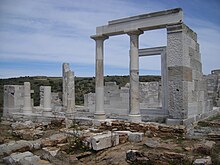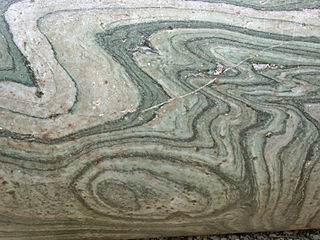
Naxian marble is a large-crystaled white marble which is quarried from the Cycladic Island of Naxos in Greece. It was among the most significant types of marble for ancient Greece and it continues to be quarried in modern times.

Naxian marble is a large-crystaled white marble which is quarried from the Cycladic Island of Naxos in Greece. It was among the most significant types of marble for ancient Greece and it continues to be quarried in modern times.

The marble's creation is owed to high level metamorphic processes in a contact zone with dome-like bulges of migmatite. [1] The two types of stone alternate in layers and the marble has a thickness of up to 30 metres in old fissures. The layers strike in a northeasterly direction.
Naxian marble is over 98% calcite. Other component minerals as dolomite, silicate and traces of graphite and pyrite. Calcite crystals are randomly distributed and usually transparent. This transparence gives the stone an appearance of depth and is the cause of the blue-grey shimmer of the marble, which is more or less noticeable depending on the angle of the light source. The crystals are up to 15 millimetres in diameter and it is thus one of the largest grained marbles on Earth. [2] In the assessment of Raymond Perrier, it has a resistance to frost and other weathering.
Other parts of the deposit have a grey colour and are clearly striped, which indicates a higher level of impurities. This variant includes the unfinished Kouros of Apollonas in a quarry near Apollonas at the north end of the island.
In many parts of the deposit, there are grey, black and coloured mineral grains in the calcite crystals of the stone at a microscopic scale, making the crystals appear cloudy. Minor organic impurities are the cause of the slightly bitumen-like smell emitted while the marble is worked; it disappears after working.




Ancient marble quarries are located in the north part of Naxos and near Apollonas, as well as in the central region of Melanes . Some unfinished ancient pieces, like the Kouros of Apollonas or the two Kouroi of Flerio are found in these quarries. Modern quarries are located near the village of Kinidaros in the central part of the island.
The use of this marble began in antiquity and has continued ever since. It was among the first types of Cycladic "island marble" to be used. It is the largest-grained marble which was used in ancient times. [3]
It was already suggested by Richard Lepsius in 1890 that Naxian marble was used for the creation of ancient roof tiles at Olympia and on the Athenian Acropolis, [4] which subsequent research affirmed. [5] In Roman times, Naxian marble has ceased to play an important role and Pliny the Elder does not mention it once.
Naxian marble is used for sculpture and decoration. In the Mediterranean region it is often employed for outdoor purposes. During the quarrying process, whiter parts of the stone are preferred. This preference has a direct impact on the price of Naxian marble in commerce. On the island it is used as a construction material for window and door frames as well as marble plaster; tailings are used as gravel and in road construction. About 5,000 m³ of high value Naxian marble is exported annually. [6]
Numerous practical and artistic deployments of Naxian marble can be found on the island. These include a modern Sphinx statue in front of the city council building of the city of Naxos, the remains of the Temple of Demeter at Sangri, the Temple of Apollo (the emblem of Naxos) and many masonry constructions in the villages.

Marble is a metamorphic rock consisting of carbonate minerals (most commonly calcite (CaCO3) or dolomite (CaMg(CO3)2) that have recrystallized under the influence of heat and pressure. It has a crystalline texture, and is typically not foliated (layered), although there are exceptions.

Naxos is a Greek island belonging to the Cyclades island group. It is the largest island in the group. It was an important centre during the Bronze Age Cycladic Culture and in the Ancient Greek Archaic Period. The island is famous as a source of emery, a rock rich in corundum, which until modern times was one of the best abrasives available.

The Town of Marble is a Statutory Town in Gunnison County, Colorado, United States. The town population was 133 at the 2020 United States Census.

Carrara marble, or Luna marble to the Romans, is a type of white or blue-grey marble popular for use in sculpture and building decor. It has been quarried since Roman times in the mountains just outside the city of Carrara in the province of Massa and Carrara in the Lunigiana, the northernmost tip of modern-day Tuscany, Italy.

Yule Marble is a marble of metamorphosed Leadville Limestone found only in the Yule Creek Valley, in the West Elk Mountains of Colorado, 2.8 miles (4.5 km) southeast of the town of Marble, Colorado. First discovered in 1873, it is quarried underground at an elevation of 9,300 feet (2,800 m) above sea level—in contrast to most marble, which is quarried from an open pit and at much lower elevations.

Noir Belge is collective noun referring to black limestone found on several sites in Belgium. Some trade names refer more specifically to the quarry where the material was found, for example "Noir de Mazy" or "Noir de Golzinne". Some Noir belge marble deposit belongs to a fine-grained calcareous sedimentary formation dated Frasnian era and located on the northern border of Namur sedimentary basin. A few black limestones located in the lower Carboniferous
Belgian marble is the name given to limestone extracted in Wallonia, southern Belgium.

Naxos, commonly referred to as Chora, is a city and a former municipality on the island of Naxos, in the Cyclades, Greece. The community has 8,897 inhabitants. It is located on the west side of Naxos Island in the Cyclades island group in the Aegean. It was an important centre of bronze age Cycladic culture and an important city in the ancient Greek Archaic Period. Since the 2011 local government reform it is part of the municipality of Naxos and Lesser Cyclades, of which it is the seat and a municipal unit.

The Archaeological Museum of Delos is a museum on the island of Delos, near Mykonos in the South Aegean, Greece. It is noted for its extensive collection of statues unearthed in the surrounding area of the ancient site, which has been declared a UNESCO World Heritage Site. Although the museum has a considerable collection, it does not contain all of the items found in Delos: a large quantity are on display in Athens at the National Archaeological Museum.

The Getty kouros is an over-life-sized statue in the form of a late archaic Greek kouros. The dolomitic marble sculpture was bought by the J. Paul Getty Museum, Los Angeles, California, in 1985 for ten million dollars and first exhibited there in October 1986.

Verd antique, also called verde antique, marmor thessalicum, or Ophite, is a serpentinite breccia popular since ancient times as a decorative facing stone. It is a dark, dull green, white-mottled serpentine, mixed with calcite, dolomite, or magnesite, which takes a high polish. The term verd antique has been documented in English texts as early as 1745.

Cipollino marble ("onion-stone") was a variety of marble used by the ancient Greeks and Romans, whose Latin term for it was marmor carystium. It was quarried in several locations on the south-west coast of the Greek island of Euboea, between the modern-day cities of Styra and Karystos. Some of these ancient quarries survive with a mine-face of over 100 metres.

The Sphinx of Naxos, also Sphinx of the Naxians, now in the Archaeological Museum of Delphi, is a 2.22 meter tall marble statue of a sphinx, a mythical creature with the head of a woman, the chest and wings composed of the impressive feathers of a prey bird turned upward, and the body of a lioness. The Sphinx stood on a 10 meter column that culminated in one of the first Ionic capitals, and was erected next to the Temple of Apollo in Delphi, the religious center of Ancient Greece, in 560 BCE.

Makrana marble is a type of white marble, popular for use in sculpture and building decor. It is mined in the town of Makrana in Rajasthan, India, and was used in the construction of several iconic monuments such as the Taj Mahal in Agra and Masjid-e-Rasheed in Deoband and the Victoria Memorial in Kolkata. The Makrana Marble is listed as a GHSR by International Union of Geological Sciences

The Colossus of the Naxians is a kouros statue made of Naxian marble which was about 9 metres high, now located in the Museum on Delos and originally from one of the islands of the Cyclades. The colossus is an example of archaic monumental sculpture and dates to the end of the seventh century BC. The colossus is one of the largest kouros statues yet known. Only the Kouros of Apollonas, which remains unfinished in the quarry at Apollonas, is larger at 10.7 m tall. The Colossus of the Naxians is now broken into many pieces.

The Kouros of Apollonas, also called the Colossus of Dionysus, is a 10.7 metre tall unfinished statue of light grey Naxian marble with a weight of around 80 tonnes. It is located in an ancient quarry near Apollonas, a small town in the northern part of Naxos, one of the Cycladic Islands in the Aegean Sea. The statue is a kouros dating from Archaic period of Ancient Greece, around the turn of the seventh and sixth centuries BC.

The Temple of Sangri is a Late Archaic Greek temple on the Cycladic island of Naxos in the area of Gyroulas, about 1.5 km south of Ano Sangri. The temple was built around 530 BC and is one of the earliest Ionic temples. It was built completely from Naxian marble.

The Kouros of Flerio is 4.7 metre long statue (Kouros) of white Naxian marble, located in a village garden in Melanes, a small village on Naxos, one of the Cycladic islands, in Greece. A second, similar kouros is located in a quarry near Melanes. They each weigh between 5 and 7 tonnes. The largest kouros on Naxos at 10.45 metres long is the Kouros of Apollonas, which weighs 80 tonnes.

Tākaka marble is a marble found in the area around Tākaka in the northern South Island of New Zealand. It comes from number of quarries on Tākaka Hill and the Holyoake Valley nearby, which form part of the Tākaka Terrane.